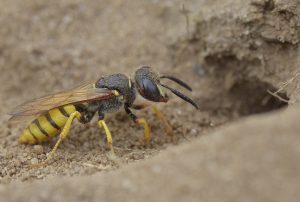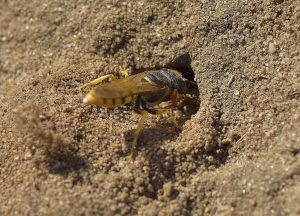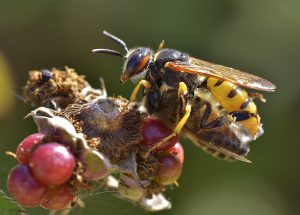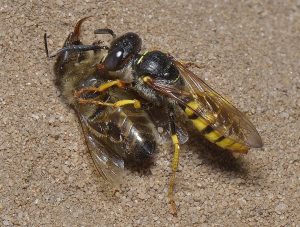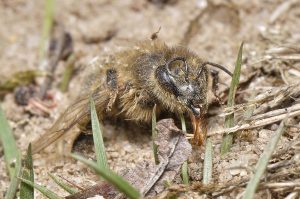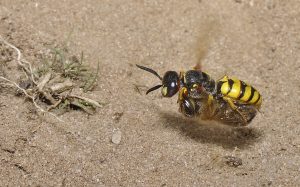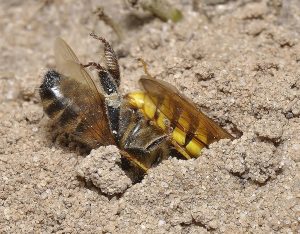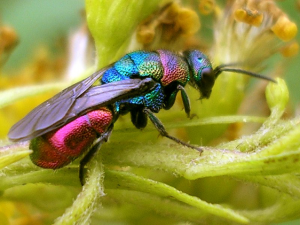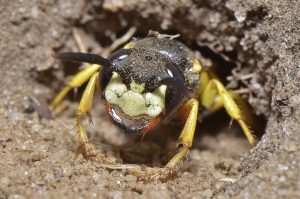Over the last year we have explored species ‘new’ to Rushcliffe that may have arrived as a consequence of range expansion: Silver-washed Fritillary, Ivy Bee and Purple Emperor. Tim Sexton’s recent talk, part of our Winter Wildlife Talks Programme, raised the possibility of adding to that list a small, but truly fascinating insect with a remarkable lifestyle.
The Beewolf
Philanthus Triangulum is a species of Digger Wasp. It has clearly been well studied, given the amount of research-based information available and, whilst widespread in the northern hemisphere, it is relatively uncommon in the UK – but that appears to be changing.
It gets its common name – Beewolf, aka the bee-killer wasp – from the way the female predates the Honey Bee Apis mellifera.
Beewolves are typically ‘wasp-shaped’ with a very narrow waist between thorax and abdomen, and are generally yellow and black in colour, although colours and markings can vary. Body lengths vary from 8 to 18 mm, with females larger than males. Males have large mandibles on their head to mark out territory and attract females in the mating season. A female has strong bristles on its front feet which are used to dig, and a sting at the rear which is missing in males.
Adults are on the wing from early-July to mid-August, and prefer warm, dry, sunny habitats such as flat grassland, heaths, dry meadows and open sandy areas, sometimes on the edges of sandy pits and banks. Possibly their best known location in the UK is RSPB Minsmere, where they are one of the attractions in mid-Summer of the now famous ‘Digger Alley’, alongside the path to the North Wall.
The male is almost incidental to the Beewolf story; it is born, digs a burrow for shelter near to females’ nests, establishes its territory by marking twigs and other objects with pheromones, feeds, waits to be chosen by a female, mates and eventually dies.
The female, on the other hand, is the real star of the Beewolf story.
The female Beewolf
She digs a tunnel up to one metre long which slopes down at 30 degrees initially before levelling out, from which lateral tunnels (as many as 34 have been found) branch off, each ending in a brood chamber. Having mated, she then lays her eggs, one in each chamber. After 2 to 3 days, eggs hatch as white maggot-shaped larvae.
The larvae are carnivorous, and this is where the female Beewolf differs from the male, demonstrating the behaviour that earns the species its name. While the male feeds on nectar from plants, the female relies almost entirely on worker Honey Bees to feed herself and her offspring.
Unless the nest is in a sheer face, the female will seal it every time she leaves, and when she returns with prey. It is thought that the female marks the opening with a pheromone on leaving, and orientates herself by flying around the nest, possibly to fix ‘local landmarks’ to enable her to find the nest. This is important; although termed a ‘solitary’ wasp, Beewolves can aggregate in colonies of several thousand nests in relatively small areas.
She uses visual skills and a strong sense of smell to detect a flying Honey Bee and catches it with her front legs. Having located the correct target position with special sensitive hairs, she uses her sting to inject poison into the bee, which paralyses it. The bee is defenceless, as its own sting cannot fix onto the smooth surface of the Beewolf and cannot penetrate the outer surface.
If feeding itself, the Beewolf presses out nectar and bodily fluid from the bee, eats it and leaves the ‘empty’ bee.
Other paralysed bees are taken back to the burrow as food for the larvae; each brood chamber is stocked with up to six bees, which the larva eats within a fortnight. Each larva spins a cocoon attached to the brood cell wall within which it pupates and overwinters, emerging as an adult next summer.
One female Beewolf can collect over 100 bees during her flight period; one study describes an aggregation of 3,000 beewolves capturing up to 30,000 Honey Bees per day. Another study suggests an aggregation may be as large as 15,000 burrows.
Protecting the young
To counter the humid and warm conditions likely in the brood cell, Beewolves have evolved three different ways to protect against likely pathogens and so reduce infant mortality. A female applies large amounts of an anti-condensation secretion from a cephalic gland to the stored honeybees, which significantly delays fungal growth on them. The Beewolf egg releases nitric oxide which reacts to atmospheric oxygen to form nitrogen dioxide, to kill any actively-growing fungi. Finally, the female Beewolf secretes a whitish substance from specialised antennal glands to the brood cell itself; this contains symbiotic bacteria of the genus Streptomyces which are taken up by the larva and applied to its cocoon, so significantly reducing fungal infestation. As a final gift to its offspring, the female Beewolf marks the ceiling of the cell with her antennal glands to guide the newly-emerged insect out of the nest.
Distribution
Common in mainland Europe, the Beewolf was regarded as rare in the UK, but since the mid-1980s its range has expanded, in response to periods of increased summer warmth; a distribution map on the BWARS website clearly shows its range expanding westwards and northwards from its previous strongholds in southern and eastern England. In recent years it has been found as far north as Yorkshire.
More relevantly for us though, in the last two years there have been a number of sightings in Nottinghamshire (recorded on NBN Atlas and Eakring Birds websites), as well as in counties to the east and south. Added to these, Tim Sexton recorded sizeable numbers around the old Rufford Colliery site that has been returned to nature by NWT and others, with one aggregation estimated at around 300 individuals.
Looking ahead
So, as the Beewolf expands its range as a result of warmer summers, and we are anticipating warmer weather as a consequence of climate change, does that mean that its recent appearance in the county is not unexpected, and that its presence will continue to grow? According to a paper by a group of European academics, the answer is ‘yes’. (Olszewski et al. October 2022. Regional Environmental Change).
Their models, using beewolf occurrence records and best and worst case climate scenarios strongly suggest that climatically suitable areas for the beewolf will increase significantly (by c. 100% by 2070); its distribution northwards will increase and cover nearly the entire British Isles.
Cuckoo in the nest
In 1733 Jonathan Swift wrote ‘Big fleas have little fleas upon their backs to bite them, and little fleas have lesser fleas, and so ad infinitum’, and so it is with the Beewolf. Its ‘lesser flea’ is the much smaller (6 to 10mm long) Cuckoo Wasp Hedychrum rutilans which targets Beewolf larvae. It lays an egg on a paralyzed honeybee, either when the Beewolf is away from the nest or when dragging its prey into the nest. The emerging larva then eats the Beewolf larva(e) and bee.
Occurring across North Africa, mainland Europe and the Channel Islands, it is known to wipe out Beewolf populations. Previously extinct in the UK, there are a small number of records in the last three years in southern England.
There appears to be a possible, striking, parallel. Another species of Cuckoo Wasp, Hedychrum nobile was first found in the county by Tim Sexton at Rufford Colliery in 2020, with further sightings nearby in 2021. A close relative of H. rutilans, it parasitizes a particular species of solitary wasp, in this case Cerceris arenaria, aka Sand-tailed Digger Wasp.
Also known as the Weevilwolf, C. arenaria (left) predates Vine and Heather Weevils Like the Beewolf, it is found across mainland Europe, and has spread into southern England from where it is expanding northwards, in a similar pattern to the Beewolf, and has also been found in good numbers by Tim Sexton at Rufford Colliery.
So, could this occurrence of Beewolves in the county be followed by their own predator wasps, in the same way that Weevilwolves have been followed by theirs?
And finally …
It looks as though this fascinating, highly-evolved little creature the Beewolf is here now, and may occur in greater numbers in the future. Perhaps we should all look out for it and, if we find it, rejoice … and, of course record it. Keep those eyes peeled!
Chris Overton February 2023
Footnote
I have been fascinated by the Beewolf ever since seeing them at Minsmere in 2015 and over the years have accumulated material about them from a number of sources and websites (some of which seem to have since disappeared), which has formed the basis of this article. They include: BWARS; Insectoid; Wikipedia; Devon Wildlife Trust; Evolutionary Ecology; Eakring Birds; NBN Atlas; Researchgate; Phys; eLife; Science Illustrated; National Geogrsaphic; iNaturalist; Science Daily, and Scottish Pollinators). Thanks also to Tim Sexton for additional data on Rufford Colliery.
Image of Hedychrum rutilans © Pudding4brains, Wikipedia Creative Common. All other images by Chris Overton ©

